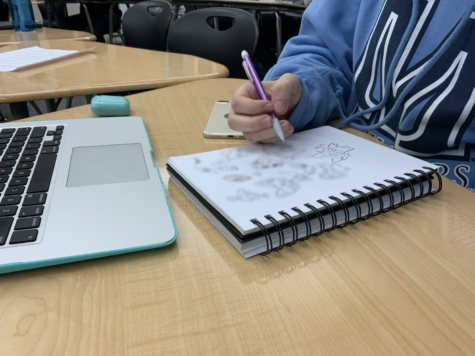Drawing in Class
November 30, 2021
We’ve all been there. time is ticking and the teacher is droning on. There’s a blank spot in the corner of your notebook, and something is telling you, screaming at you, that you need to fill it with something. Absent-mindedly, doodles start to form, hearts, swirls, eyes, all appear. However, how do the teachers feel?
When asked how teachers feel, Math teacher, Bruce Mabbott had this to say, “It depends; if it’s just kind of like a subconscious doodling whilst thinking, or pondering, or mulling something over, I think that’s totally fine.” He continues by stating “As we’re reviewing or as I’m presenting a new topic you know obviously I see some students doodling in the margin or like doodling in their notebooks, totally fine. If, however, it gets to be something they’re doing instead of working, which has happened, then it becomes more of an issue,” which brings up a good point of the types of drawing that happens in class. Mr. Mabbott raises the point of “As human beings, we are really bad at multitasking. We think that we’re good, but we’re really not. So if the student is concentrating on sketching, or the doodling, or the drawing, then they’re usually not concentrating on what is being said in class.” This is a valid point.
There have been studies on how doodling whilst doing something else, can improve memory. A 2016 Harvard article, written by Srini Pillay, MD, writes about a 2009 experiment, where 40 people were asked to listen to a 2 ½ minute rambling speech. Half doodled while listening, and the other had to just listen. When the groups were asked to recall the message, the group that doodled remembered 29% more than the group that didn’t doodle. It’s thought that it’s due to the brain’s fight or flight coping method, needing to stay occupied to stay focused.
To see all perspectives, I asked students their experiences with drawing in class, to see if it helps or hurts them. When I asked why she drew in class, Senior, Lydia Hickey, had this to say “I need something to do with my hands.” Senior Natalie Sabino, answered “Because I like to draw, and it helps me focus sometimes, especially when the class is getting slow because it gives me something to do with my hands and be kind of productive in its own sense.”
Fidgeting is the act of making small movements, especially of the hands and feet, through nervousness or impatience. For some, it can be a way to focus on something else by keeping your mind at bay. In recent times, fidgeting and fidget toys have been a trend, some notable examples are fidget spinners, fidget cubes, Rubik’s cube, and more recently, pop its. Though the toys can be helpful in giving your hands something to do, with their popularity, comes people misusing them and thus being banned in schools. However drawing is something that most people don’t think too much about.
When asking about drawing and doodling, it was a no brainer to ask the opinions of two art teachers, Alysha Elliard and Catherine Morris. When asked if drawing in class was appropriate, Ms. Morris replied by stating, “That’s where it gets kind of tricky; I think for some people, drawing can help them focus, because it gives their hands something to do, so that they’re physically quieting themselves so their mind can absorb. However, I do not think for the majority of people it is helpful. For me, it helps me get into kind of a “flow state” where it almost induces daydreaming and can help me be more creative because I’m losing myself in my drawing.” This was interesting and related to Ms. Elliard’s response. She said, “I think it’s really helpful for a lot of people to be doodling while you’re listening or doing other things, because it helps process information better.” They both bring up very good points. For some people, doodling can be very helpful but for others it can lead to their downfall.
The debate on whether or not doodling is beneficial is still ongoing. There are clear arguments from both sides, although it seems most teachers don’t mind when students draw in class. My personal opinion is that students should do what works for them; though if a teacher shows distaste for doodling, perhaps trying to respectfully reason with them and come to an understanding could be helpful.

